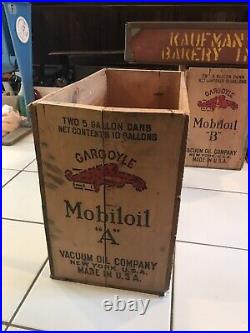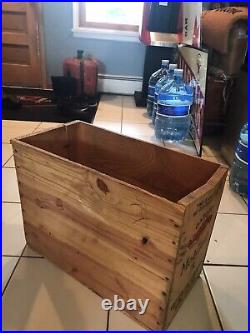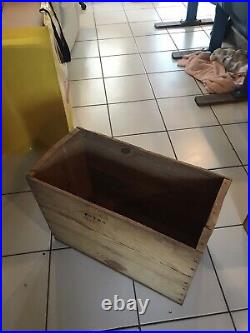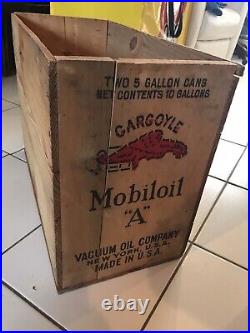




So here is very old wood case in aged used split faded chipped splintered as is condition see pics measuring about 10 by 21 by 16H. Signs in pictures are not included and are listed seperately here on E Bay see my listings for more great old original treasures! “Socony Gasoline”, Standard Oil of New York plant in New Bedford, Massachusetts. Socony gas station between Norwich and New London on Route 32 in Connecticut, 1916. Following the break-up of Standard Oil. In 1911, the “Standard Oil Company of New York” (or’Socony’) was founded, along with 33 other successor companies. Was head of the company until 1923, when he was succeeded by Herbert L. Beginning February 29, 1928 on NBC. Socony Oil reached radio listeners with a comedy program, Soconyland Sketches. Scripted by William Ford Manley and featuring Arthur Allen and Parker Fennelly. As rural New Englanders. Socony continued to sponsor the show when it moved to CBS. In 1935, it became the Socony Sketchbook, with Christopher Morley. And the Johnny Green. Socony petrol station in the Dutch East Indies. In 1931, Socony merged with Vacuum Oil. In 1933, Socony-Vacuum and Jersey Standard. (which had oil production and refineries in Indonesia) merged their interests in the Far East into a 50-50 joint venture. Or “Stanvac”, operated in 50 countries, including New Zealand, China, and the region of East Africa. Before it was dissolved in 1962. In 1935, Socony Vacuum Oil opened the huge Mammoth Oil Port on Staten Island. Case United States v. The case originated with Socony-Vacuum’s practices of organizing a cartel among the “major” oil companies in which they bought oil-known as “hot oil”-from independent producers and stored the surplus in tanks to limit the supply of oil available on the market and keep the price of oil artificially high. In its decision, the U. Ruled that regardless of the purpose of the price fixing or if the prices varied, such conduct was illegal in and of itself: Under the Sherman Act. A combination formed for the purpose and with the effect of raising, depressing, fixing, pegging, or stabilizing the price of a commodity in interstate or foreign commerce is illegal per se… This rule remains in use today for agreements that appear on their face to always or almost always restrict competition and reduce output. The Mobil Economy Run generated publicity and promotions. Such as this 1962 advertisement by Champion spark plugs. With a Rambler American. In 1955, Socony-Vacuum was renamed Socony Mobil Oil Company. In 1963, it changed its trade name from “Mobiloil” to simply “Mobil”, introducing a new logo created by New York graphic design firm Chermayeff & Geismar. To celebrate its 100th anniversary in 1966, “Socony” was dropped from the corporate name. From 1936 to 1968, Mobil sponsored an economy run. Each year except during World War II. In which domestic automobiles of various manufacturers in a number of price and size classes were driven by light-footed drivers on cross-country runs. The Economy Run originated with the Gilmore Oil Company. The cars driven in the economy run were fueled with Mobil gasoline. And Mobiloil and lubricants were also used. The vehicles in each class that achieved the highest fuel economy numbers were awarded the coveted title as the Mobilgas Economy Run winner. During American involvement in World War II. April 29, 1942, Socony’s unescorted tanker, named Mobiloil, was sunk by a German U-boat. German Type IX submarine. U-108 captained by Klaus Schlotz, and all 52 people survived after 86 hours adrift in lifeboats. Socony-Mobil ranked 86th among United States corporations in the value of World War II military production contracts. Former Mobil station in Michigan, displaying several pumps and a Mobil Pegasus sign, pictured in 2008. Old Mobilgas pump displayed on the grounds of the Scurry County. Coliseum in Snyder, Texas. Through the years, Mobil was among the largest sellers of gasoline. And motor oils in the United States and even held the top spot during the 1940s and much of the 1950s. Various Mobil products during the Socony-Vacuum and Socony-Mobil years included Metro, Mobilgas and Mobilgas Special gasolines; Mobilfuel Diesel, MobilHeat and Mobil-flame heating oil, Mobil Kerosine, Lubrite. Gargoyle, Mobiloil and Mobiloil Special motor oils; Mobilgrease, Mobillubrication, Mobil Upperlube, Mobil Freezone and Permazone antifreezes, Mobilfluid automatic transmission fluid, Mobil Premiere tires, Mobil Stop-Leak, and Mobil Lustrecloth, among many others. In 1954, Mobil introduced a new and improved Mobilgas Special in response to trends toward new automobiles powered by high-compression engines that demanded higher and higher octane. The newest formulas of Mobilgas Special were advertised as offering “A Tune-Up in Every Tankful” due to a combination of chemicals known as the “Mobil Power Compound” which was designed to increase power, check pre-ignition ping, correct spark plug misfiring, control stalling and combat gumming up of carburetors. Later Mobil campaigns advertised Mobilgas as the “New Car Gasoline” following extensive testing during the annual Mobilgas Economy Run. In 1958, Mobil fueled the first transatlantic Boeing 707. Commercial flight using its aviation fuel. And the flight flies from New York City. Vintage pumps, manufactured by Tokheim. Using the pre-1962 “Mobilgas” product name. In 1962, the gasoline product lines marketed as Mobilgas and Mobilgas Special were rebranded as Mobil Regular and Mobil Premium in a move to emphasize the shortened brand name “Mobil” in promotional efforts, although Mobiloil continued as a single-word term until the 1970s. After a few years of advertising Mobil gasolines as “Megatane”-rated and as “High Energy” gasolines, Mobil began, in 1966, to promote both its Regular and Premium fuels as “Detergent Gasolines”, due to the inclusion of additives designed to clean carburetors. And various internal engine parts. During the early 1970s, Mobil ran a TV commercial featuring a character known as Mr. Dirt to show the ruinous effects that dirt had on automotive engines for which a tank of Mobil Detergent Gasoline could provide a cure and preventive medicine against damage that could lead to costly repairs. 1975 saw Mobil Oil construct Beryl A, the first offshore oil production platform. Made out of concrete. Mobil credits Beryl A with being the prototype for other concrete-based deepwater oil platforms in the North Sea. As automakers were switching en masse from carbureted to fuel-injected. Engines during the early to mid-1980s, and the detergent additives that existed in most available gasolines proved not to be enough to prevent injection clogging, leading to drivability problems, Mobil received accolades from General Motors. And other automakers for increasing the detergency of its Super Unleaded gasoline in 1984 to prevent formation or deposit build-ups of the injectors but also remove existing deposits as well in normal driving. Who converted them into Hydro. In October 1983, Howard B. Keck stepped down as a director, while still controlling 18.4 percent of the company, saying he wanted to sell his stake in Superior Oil Company. In late 1983, an “uneasy truce” was reached between two major stockholders, former chairman Howard B. Keck and his sister Willametta Keck Day. Day had in April of that year. Howard Keck had opposed the bylaw change. He reversed his position on the bylaws November 1983. And disclosed his intention to sell his stake. Several months before March 1984, the Keck family, which owned a total of about 22 percent of the stock of Superior, approached Mobil Corporation (now part of ExxonMobil) with an offer to sell the family stock. At that time the company was the nation’s largest independent oil producer. The takeover was completed in September 1984, with Superior, then based in Houston, becoming a wholly owned subsidiary of Mobil. Was President of Mobil Corporation until succeeded by Allen E. Mobil moved its headquarters from 150 East 42nd Street. To Fairfax County, Virginia. To Standard Oil of Ohio. Which had just been fully acquired by BP. And terminated franchise contracts with the rest of the stations in the area, withdrawing the Mobil brand from the area for 29 years until a Uni-Mart. Location in Coraopolis, Pennsylvania. In 1998, Mobil and Exxon agreed on a merger to create ExxonMobil. Which was completed on November 30, 1999. Was Chairman of Mobil at the time of the merger, and Walter Arnheim. This item is in the category “Collectibles\Advertising\Gas & Oil\Merchandise & Memorabilia\Signs”. The seller is “erp7777″ and is located in this country: US. This item can be shipped to United States, Canada, United Kingdom, Denmark, Romania, Slovakia, Bulgaria, Czech Republic, Finland, Hungary, Latvia, Lithuania, Malta, Estonia, Australia, Greece, Portugal, Cyprus, Slovenia, Japan, China, Sweden, South Korea, Indonesia, Taiwan, South Africa, Thailand, Belgium, France, Hong Kong, Ireland, Netherlands, Poland, Spain, Italy, Germany, Austria, Bahamas, Israel, Mexico, New Zealand, Philippines, Singapore, Switzerland, Norway, Saudi Arabia, United Arab Emirates, Qatar, Kuwait, Bahrain, Republic of Croatia, Malaysia, Brazil, Chile, Colombia, Costa Rica, Panama, Trinidad and Tobago, Guatemala, Honduras, Jamaica, Antigua and Barbuda, Aruba, Belize, Dominica, Grenada, Saint Kitts-Nevis, Saint Lucia, Montserrat, Turks and Caicos Islands, Barbados, Bangladesh, Bermuda, Brunei Darussalam, Bolivia, Ecuador, Egypt, French Guiana, Guernsey, Gibraltar, Guadeloupe, Iceland, Jersey, Jordan, Cambodia, Cayman Islands, Liechtenstein, Sri Lanka, Luxembourg, Monaco, Macau, Martinique, Maldives, Nicaragua, Oman, Peru, Pakistan, Paraguay, Reunion, Vietnam.
- Brand: GARGOYLE
- Type of Advertising: Sign
- Date of Creation: 1920-30s
- Theme: Gas & Oil
- Original/Reproduction: Original
- Country/Region of Manufacture: United States

